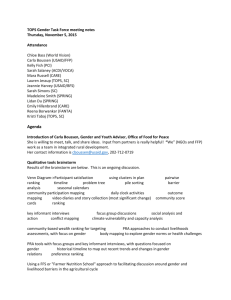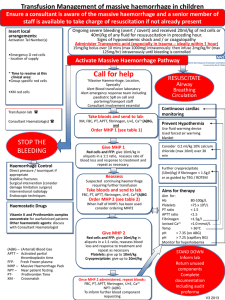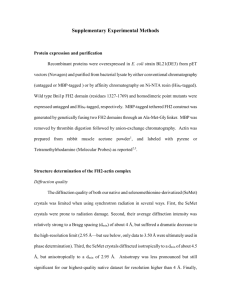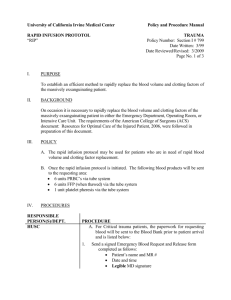Preferences, market structure, and welfare evaluations in the
advertisement
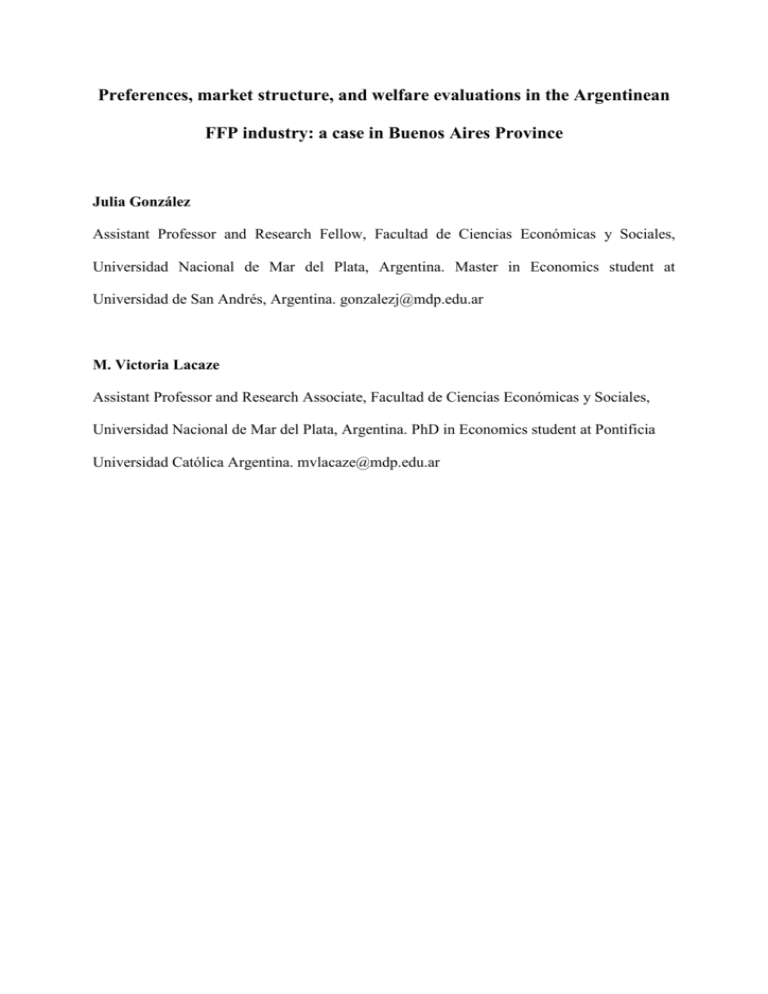
Preferences, market structure, and welfare evaluations in the Argentinean
FFP industry: a case in Buenos Aires Province
Julia González
Assistant Professor and Research Fellow, Facultad de Ciencias Económicas y Sociales,
Universidad Nacional de Mar del Plata, Argentina. Master in Economics student at
Universidad de San Andrés, Argentina. gonzalezj@mdp.edu.ar
M. Victoria Lacaze
Assistant Professor and Research Associate, Facultad de Ciencias Económicas y Sociales,
Universidad Nacional de Mar del Plata, Argentina. PhD in Economics student at Pontificia
Universidad Católica Argentina. mvlacaze@mdp.edu.ar
Preferences, market structure, and welfare evaluations in the Argentinean
FFP industry: a case in Buenos Aires Province
Abstract
This paper analyzes the demand of frozen fried potatoes in an important city of Argentina,
Mar del Plata, and the effect of changes in market structure on consumer welfare. We find
that high income individuals are more concerned about health and nutrition, and that younger
and lower-income consumers are more price sensitive. The results suggest that consumer
surplus would decrease with a merger between the two smaller firms of the market, and
would increase if the market turned into a single-product firms industry. The influence of
these counterfactual changes would be greater for wealthier and older individuals. This article
contributes to the analysis of a food market which is rapidly growing in developing countries
and is starting to play a more relevant role in consumers’ diet.
EconLit subject matter areas: [L11], [D12].
1. Introduction
The Argentinean frozen fried potato (FFP) industry is characterized by high concentration
and high degree of horizontal and vertical differentiation. There are virtually no research on
the characteristics, evolution, and development of the domestic market of FFP in Argentina.
Few exceptions are studies committed to analyze contractual relationships and integration
schemes between potato producers and agro-industry actors (Bruzone, 1998; Mateos, 2003),
but there are not investigations concerned with understanding and identifying consumers’
preferences for these products. This paper intends to fill this gap by analyzing the FFP market
in an important city of Argentina, Mar del Plata.
2
The study of differentiated-product markets is a key topic of the recent literature in empirical
industrial organization; in particular, the estimation of demand functions has introduced many
challenges.1 On the one hand, it is the computational complexity of estimating a large number
of parameters. On the other hand, a difficulty associated with the possibility of modeling the
heterogeneity in consumers’ tastes with which to get more realistic estimations of substitution
patterns and the level of product differentiation in the market. Since McFadden’s logistic
demand model (1973), the discrete choice literature has provided solutions to overcome such
obstacles, especially the Random Coefficients Discrete Choice Model (Berry, 1994; Berry et
al., 1995), henceforth RCDCM. This model has gained importance in the study of market
power, new goods, and changes in market structure of differentiated-product markets. Berry,
Levinsohn and Pakes (1999) evaluate the impact of the voluntary export restraint of Japanese
vehicles exported to the United States that was set up in 1981. Nevo (2000a, 2001) examines
collusive pricing behavior and evaluates actual and hypothetical mergers in the ready-to-eat
cereal industry. Petrin (2002) quantifies the effect of the introduction of the minivan into the
U.S. automobile market.2 However, this approach has not been yet applied to analyze the FFP
market, which is rapidly growing in developing countries.
1
Since the Linear Expenditure System (Stone, 1954), econometric estimations of demand models, such as
Rotterdam (Theil, 1965), Translog (Christersen et al., 1975), and AIDS (Deaton y Muellbauer, 1980), have
faced the challenge of achieve flexible functional forms, consistent with economic theory.
2
A lot of other studies can be mentioned. Mojduszka et al. (2001) investigate what affect consumer demand for
prepared frozen meals in U.S., and evaluate price competition in the industry and the impact of a new mandatory
labeling policy; Brambilla (2005) estimates the cost of the non-trade barriers in Argentina and Brazil bilateral
trade of vehicles during 1996-1999, and assesses the impact of a counterfactual equilibrium in which the nontariff barriers are removed and the common external tariff is adopted; Lopez & Lopez (2009) analyze consumer
choices, demand elasticity, and price competition in a differentiated fluid milk market in Boston, MA; among
others.
3
The objective of this paper is to explore consumers’ preferences for FFP through the
estimation of flexible elasticity coefficients and to measure the effect of hypothetical changes
in FFP industry market structure on prices, sales, and consumers’ surplus. To achieve this
goal a RCDCM of household demand is estimated. The main data source is a monthly threedimensional panel of quantities and sales for a five-year period provided by a local
supermarket chain; socioeconomic information from the households’ survey of the Instituto
Nacional de Estadísticas y Censos (INDEC) of Argentina is the auxiliary data set. The
individual-specific parameters of the utility function are estimated, as well as the own- and
cross-price elasticities. Then, the marginal costs for the available products are obtained and
counterfactual market structures are simulated. Finally we recover equilibrium prices after the
proposed scenarios and calculate consumers’ welfare changes.
The rest of the paper is organized as follows. A brief overview of FFP world market and
some notes about the Argentinean case are presented in Section 2. Section 3 outlines the
theoretical framework of discrete choice models. Data, estimation, and identifying
assumptions are presented in Section 4. Results are reported in Section 5. Lastly, Section 6
concludes the paper.
2. The frozen fried potato industry
Potato is an extensive annual crop of relative high cost, whose productivity can be limited by
agro-ecological conditions, water availability, technology, and use of fertilizers and other
agrochemicals. These constraints are especially important when considering potatoes destined
to processing, as FFP, due to the quality standards usually required. Straight-cut fries (“papas
bastón” in Spanish) are the Argentinean FFP industry main product, even though there are
others, like slices, noisettes, croquettes, etc.
4
FFP is an extensively consumed food in developed countries, mainly in North America.
Although the FFP market has reached maturity in the United States, FFP consumption has
rapidly grown in the developing countries, which is related to the higher women’s labor force
participation rates, the higher frequency of eating-out, and other changes in working patterns.
All this has caused a rise in the demand for fast food, a market dominated by multinational
chains that is the principal FFP supplier. The production of these goods is mainly
concentrated in the United States, The Netherlands, Canada, and Belgium, which also are the
top exporters. A few companies dominate this market in Mercosur: McCain supplies
McDonald’s, while Alimentos Modernos supplies Burger King and offers two own brands,
FarmFrites and RapiPap. In Argentina, FFP production amounted to 215,000 tons in 2001
(last available figures), accounting for 80% of the potatoes destined to industrial processing
(Mateos, 2003). Argentinean households’ direct demand for FFP is primarily supplied by
super and hypermarkets, even though restricted because of the high prices if compared with
fresh potatoes.
3. Discrete-choice logit models
Product differentiation as a research topic of agricultural economics dates back to the decade
of the 1920s, when Waugh (1928) published his seminal work devoted to analyze the
relationship between price and characteristics of vegetables in the United States. Later,
Houthakker (1951-52) and Thail (1951-52) incorporated the product characteristics in their
utility maximization models, while Lancaster (1966) postulated that it is the properties or
characteristics of the good from which utility is derived. The Simple Logit Model
(McFadden, 1973) makes use of this conceptual framework and solves some challenges that
arise when estimating demand functions for differentiated products. Specifically, it
overcomes the dimensionality problem by projecting the products onto a characteristics
5
space. However, in this model all individuals are assumed to be identical except for the error
term, which entails strong restrictions on elasticity coefficients. On the one hand, the ownprice elasticities are almost perfectly proportional to prices when the market share of the
outside good is close to one (McFadden, 1981). On the other hand, the cross-sensitivity of
demand is the same regardless the good whose price changes, and therefore consumers
substitute towards other products in proportion to market shares, without considering the
similarity of their characteristics. More flexible substitution patterns are achieved with the
Nested Logit Model, whose estimation requires a priori clustering of products; the cross-price
elasticity coefficients are different between groups but equal within them. Finally, the
RCDCM (full model) allows for flexible own-price elasticities driven by the different price
sensitivity of different consumers, and for cross-price substitution patterns driven by product
characteristics and not constrained by arbitrary segmentation of the market. Table 1
synthesizes the advantages and limitations of the discrete-choice logit models.
[Table 1. Discrete-choice logit models]
The rest of the section presents the RCDCM of demand, the assumed supply behavior, and a
measure of welfare change. In general terms, the idea is to estimate the structural parameters
that govern demand and supply and to use them to analyze the effects on welfare of
counterfactual changes of FFP market structure.
3.1 Demand
Suppose t = 1,…, T markets (as defined below) are observed, each with i = 1,…, I consumers.
The conditional indirect utility of consumer i from product j (j = 1,…, J) at market t is
(1)
where
is a K-dimensional (row) vector of observable product characteristics,
price of product j in market t,
is the
is the mean valuation of the unobserved product
6
characteristics, Δ
is a market specific deviation from this mean, and
is a mean-zero
stochastic term distributed i.i.d. with Type I extreme-value distribution. Finally,
are
K + 1 individual-specific coefficients, defined following the approach of Nevo (2001) as:
(2)
~
where
0, !"#$
is a d % 1 vector of observed
are the mean parameters of the utility function,
demographic variables,
is a vector of normal random shocks in tastes,3
is a (K + 1) % d
matrix of coefficients that measure how the taste coefficients vary with demographics, and
is a scaling matrix.
The consumers may decide not to purchase any of the products, in which case they choose
the “outside good”. Without this allowance a homogeneous price increase of all products
does not change quantities purchased. The indirect utility from this outside option is
&
&,
The mean utility of the outside good,
Let )
'&
&
(&
&
&
is not identified, so it is normalized to zero.
)$ , )* be a vector containing all parameters of the model. The vector )$
contains the linear parameters and the vector )*
,
,
, the nonlinear parameters. 4
Combining equations (1) and (2):
+ ,
(3)
,
+
3
The vector
,
,Δ
; )$ .
;/
/ ,
,
0
, ,
, 1
; )* .
2
represents the unobserved individual characteristics (i.e., not available in the auxiliary dataset)
that affect preferences.
4
The reason for distinguishing between linear and nonlinear parameters has to do with how they enter the model
and the estimator, as will be shown below.
7
where + represents the mean utility, which is common to all consumers, and /
is a
mean-zero heteroskedastic deviation from that mean that captures the effects of the random
coefficients.
It is assumed that consumers purchase one unit of the good that gives the highest utility.5 This
implicitly defines the set of individual-specific variables that lead to the choice of good j:
3
,
.
, +. ; )*
5
, ,
|
6
7
89
0,1, … , <=
Assuming ties occur with zero probability, the market share of the jth product as a function of
the mean utility levels of all the J + 1 goods, given the parameters, is
(4)
>
,
.
, +. ; )*
? @A
BCD
, ,
? @AE
BCD
@AF
@AG
where A · denotes population distribution functions. The second equality is a consequence
of an assumption of independence of , , and . Unlike the Simple Logit Model, in the full
model the market share equations do not have an analytic closed form, therefore the integral
given in equation (4) has to be computed numerically, as will be shown below.
Since the main data source includes aggregate sales data, heterogeneity can be modeled either
by assuming a parametric distribution of A · (Berry, 1994; Berry et al., 1995) or as a
function of the empirical nonparametric distribution of demographics (Nevo, 2001). We
implement the second option in this paper, which allows us to assess the joint distribution of
the demographic variables in .
3.2 Supply
Suppose there are F firms, each of which produces some subset, IJ , of the j = 1,…, J
different products. The profits for a firm f are
5
This is a reasonable assumption since most people consume only one kind of FFP at a time.
8
J
(5)
where >
K,
LM .N>
PIQ
OJ
is the market share of product j, which is a function of the prices of all products,
N is the size of the market,6 LM is the constant marginal cost of production, and OJ is the
fixed cost of production. Assuming the existence of a pure-strategy Bertrand-Nash
equilibrium in prices, and that the prices that support it are strictly positive, the price
of
any product j produced by firm f must satisfy the first-order condition
(6)
>
K
RPIQ
R
LMR
S>R
S
0
In vector notation, the first-order conditions become
(7)
>
T.
LM
0
where T is the ownership matrix, whose element T R equals one if j and r are produced for
the same firm, and zero otherwise.
is the derivative matrix, where
R
⁄S
S>R
,
which is obtained when estimating the demand model. This implies a system of equations to
compute the marginal costs, which are not observed:
(8)
LM
T.
V$
>
Equation (7) also provides an equation to predict counterfactual equilibrium prices,
(9)
LM
W
T .
V$
:
>
where LM
W are the estimated marginal costs, and T is the ownership matrix that represents the
hypothetical market structure of the counterfactual scenario. When computing post-change
equilibrium prices and market shares we make two important assumptions. First, we assume
6
The market size defined in this model includes the share of the outside good, which allows keeping the market
size fixed while still allowing the total quantity of products sold to increase. Therefore, the analysis of a
hypothetical change in market structure is less sensitive to the exact definition of market size.
9
that the cost structure stays the same before and after the changes. Second, the derivative of
shares with respect to prices, matrix , also remains unchanged.
3.3 Consumer welfare
The measure we use to evaluate the changes in consumer welfare as a result of hypothetical
scenarios is the compensating variation. Unlike the Simple Logit Model, this measure does
not have an analytical solution for the full model when
in equation (1) is a function of
income. In this case, the compensating variation of individual i, OX , has to be computed
iteratively, and is equal to
ΔY , where ΔY solves
Y,
Y
where Y is the income of individual i and
ΔY ,
is the vector of prices in the initial situation. The
mean compensating variation in the population is given by
(10)
where
OX
? OX @AE
@AF
is the total number of consumers.
Two assumptions have to be made when computing these changes in consumer surplus. First,
as with the observed characteristics, there is no change in the unobserved components,
.
Second, there are no changes in the utility from the outside good.
4. Data, estimation, and identifying assumptions
4.1 Data
The data required to consistently estimate the model previously described consist of the
following variables: market shares and prices in each market (as defined below), product
attributes, and demographic characteristics of individuals. Since we do not possess
information about individual purchases, we match scanner data with an auxiliary database,
10
which provides the distribution of demographic variables across population in each market, in
order to identify the variable part of the coefficients.
The scanner database was provided by a traditional supermarket chain in Mar del Plata,
Supermercados Toledo S. A., and consists of the value of monthly sales and the quantity sold
for each product and each of the 23 branches of the supermarket, from July 2005 to
December 2009. The city of Mar del Plata is located on the Atlantic Ocean cost, 400
kilometers (249 miles) south of Buenos Aires City, the capital city of Argentina. It is one of
the major fishing ports, an important industrial area, and the biggest seaside beach resort in
the country. With a population of roughly 600,000 inhabitants, Mar del Plata is the second
largest city of Buenos Aires Province and the seventh largest Argentinean city, and is the
main urban center of the major potato production area of the country, which is located in the
southeast Province of Buenos Aires. Figure 1 shows the geographical distribution of the
supermarket branches, confirming their widespread allocation in the city.
The sales data cover 18 FFP products supplied by three firms (McCain, Alimentos Modernos,
and Granja del Sol) through four brands (McCain, FarmFrites, Granja del Sol, and RapiPap),
and are classified in six segments or varieties (bastón, golden longs, noisette, rondelles,
smiles, and croquettes) and offered in several container sizes. Nutritional information about
calories, saturated fat, fiber, and sodium was collected by visual inspection of the products’
nutrition facts labels. Unit value per serving was calculated as a proxy for price, by dividing
the value of sales by the quantity of servings sold, which was computed as the package size
divided by the serving size7 and multiplied by the quantity of units sold.
[Figure 1. Allocation of Supermercados Toledo branches in Mar del Plata, Argentina]
Information on the distribution of demographics was obtained by sampling individuals from
the Encuesta Permanente de Hogares (EPH), which is carried out by the Instituto Nacional
7
According to the Argentine Food Code, the size of a serving of FFP is 85 grams (2.99 oz).
11
de Estadísticas y Censos (INDEC) in several cities of the country; in this paper we use the
information about households of Mar del Plata. The socioeconomic variables of interest are
per capita income and average age of the household members, which is related with both
household size and presence of children.
In order to match both data sets it is necessary to define the criterion for aggregating sales
data and sampling simulated individuals, i.e. to define a market. Since the EPH does not
provide the geographical location of surveyed households, it is not possible to define a
market as a combination of a geographical area and a unit of time, as in most previous work,
which in our case would be a branch-month combination. Therefore, a market was defined as
an income-month combination, and the data were prepared following three steps. First, the
per capita average income of each Mar del Plata census tract was calculated using data from a
household survey. 8 Second, the potential customers of each supermarket branch were
identified according to the population of the census tract in which the branch is located.
Finally, the branches were classified by the income level of their potential buyers (high,
upper-middle, middle, lower-middle, and low)9, and sales data of branches with the same
income level were aggregated by month and product. Thus, the data were structured in 270
markets (5 income levels by 54 months) and 2,145 observations (considering different
products sold in each market). The demographic characterization of each market was
8
This data come from a probabilistic 500-household survey about potato consumption conducted in Mar del
Plata in June 2009 by the Grupo de Economía Agraria of the Facultad de Ciencias Económicas y Sociales,
Universidad Nacional de Mar del Plata, Argentina (Rodríguez et al., 2010).
9
These income categories were defined according to the average quintile income of the households surveyed by
the EPH in the second quarter of 2009, period in which the potato consumption survey was carried out.
12
accomplished by randomly drawing simulated individuals from the corresponding period and
quintile of the EPH.10
Lastly, to calculate the market shares it is necessary to assess the market size, i.e. the total
potential demand for FFP of the supermarket chain. This was obtained as the 35%11 of the
total potential demand of the city, which in turn was calculated by imputing the FFP
consumption frequency of “real consumers”12 to the entire city population. This was done for
each of the branches regarding their potential customers, and then the market size for each
income-month combination was calculated. The market share for each product in each market
was determined by dividing the quantity of servings sold by the market size.
Table 2 presents the characteristics of the FFP products covered by our scanner database. We
assign them an identification number (ID) which we will refer to in the results section. Bastón
is the most popular variety followed by noisette, despite its relatively high price. On the other
hand, croquettes and rondelles are the segments with the least market shares. It can be seen
that Toledo customers can take advantage of economies of scale in these products, since price
per serving decrease as container size increases, at equal value of the other characteristics.
Table 3 reports FFP average prices by segment and income level. For all varieties, prices
increase with income; golden longs, rondelles and bastón are the least expensive products in
all income levels, and croquettes are the most expensive. The last column shows the
percentage difference between average prices in high- and low-income-level markets.
Consumers of high income-level face higher prices than consumers of low income-level for
10
Since the EPH is a quarterly survey, three random samples had to be drawn for each quarter and quintile. The
sample size (ns) is of 180 individuals by market.
11
This is the Supermercados Toledo share of total supermarket sales in Mar del Plata, according to the opinion
of key actors in the supermarket industry.
12
This refers to the FFP consumption frequency of those polled in the potato consumption survey who declared
they consume FFP.
13
any product variety, which suggests the presence of a price discrimination strategy
implemented by sellers. Golden longs and smiles are the segments in which the highest
surcharges are imposed, while bastón and noisette present the lowest surcharges.
[Table 2. Product characteristics, market shares, and prices]
[Table 3. FFP average prices by segment and income level]
Lastly, Table 4 shows average prices by brand and income level. Such as in the previous table,
prices increase with income regardless the brand. Granja del Sol offers the most expensive
products on average, while RapiPap FFP are the least expensive options.
[Table 4. FFP average prices by brand and income level]
4.2 Estimation
The key point of the estimation is to exploit a population moment condition that is a product
of instrumental variables and a structural error term to form a nonlinear GMM estimator. The
main technical difficulties to deal with are related to the computation of the integral in
equation (4), and to matching theoretical to observed market shares. Formally, let Z
[\$ , … , \] ^ be a set of instruments such that _[Z` · a ) ^
0, where a, a function of the
model parameters, is an error term defined below and ) denote the true value of this
parameters. The GMM estimate is
(11)
)b
arg min a ) 2 Z3V$ Z 2 a )
i
where 3 is a consistent estimate of _[Z`aa`Z^. Because of the inclusion of product-specific
dummy variables as product characteristics (as explained below), the error term is defined as
the market specific deviation from the mean valuation of the unobserved product
14
characteristics, Δ
13.
This error term is computed by solving for the mean utility levels, +. ,
that solve the implicit system of equations
(12)
>.
,
, +. ; )*
.
k.
where >. · is the market share function defined by equation (4) and k. are the observed
market shares. For the Simple Logit Model the solution is equal to l k
9l k&
, while
for the full model this inversion is done numerically. Once this inversion has been done, the
error term is defined as a
+
,
.
, k. ; )*
. The reason for
distinguishing between )$ and )* becomes clear now: )$ enters this error term, and therefore
the objective function, in a linear fashion, while )* enters nonlinearly.
The estimation algorithm implemented to compute the estimates requires the following steps
(Nevo, 1998):
(0)
Prepare the data14. Define a vector of market shares and two matrices of attributes, m$
and m*. m$ contains the variables that enter the linear part of the estimation, common to
all individuals (+ in equation (3)). m* contains the variables that will have a random
coefficient, and therefore will enter the nonlinear part (/
in equation (3)). Draw
individuals from the auxiliary database in order to obtain values for the variables in ,
and draw values for the random shocks to tastes ( ) and to utility ( ).
13
A straightforward approach to the estimation of this model is to define the error term as the difference
between the observed and predicted market shares. In this work, we define a structural error term following the
estimation method proposed by Berry (1994), which allows one to deal with correlation between the error term
and prices. The advantage of working with a structural error is that the link to economic theory is tighter,
allowing us to think of economic theories that would justify various instrumental variables (Nevo, 2000b).
14
The actual organization of the data depends on the code used to compute the estimation. We adapted a code
developed by Nevo (2000b).
15
(1)
For a given value of )* and + , compute the market shares implied by equation (4).
Assuming a Type I extreme-value distribution for , market shares are approximated by
>
.
,
.
where >
(2)
, +. , Ano ; )*
no
1
K>
l>
p$
no
q ,+
1
K
l>
∑wvp$ q
p$ 1
∑"
sp$
s
+v
,(s
s
v
s
(s
'$s
s
t
$
'$s
$
'us
t
u
..
'us
u
is the probability of individual i purchasing the product j in market t.
For a given )* , compute the vector + that equates the market shares computed in step (1)
to the observed shares, by solving the system of equations in (12). It can be solved
numerically by using a contraction mapping suggested by Berry et al. (1995).
(3)
Determine )$ according to the mean valuation computed in step (2), and compute the
error term a
+
m$ )$ . Interact a with the instruments and calculate the value of the
objective function a ) 2 Z3V$ Z 2 a ) .
(4)
Search for the value of )* updating starting values until minimizing the objective
function.
4.3 Instruments and product-specific dummy variables
As pointed out, once product dummy variables are included in the regression, the error term
is the unobserved (to the researcher) income-month specific deviation from the overall mean
valuation of the product. Since we assume that players in the industry observe and account
for this deviation (i.e., firms take it into account when setting prices, and it affects consumers’
utility and willingness to pay), it will be correlated with prices, and therefore least-squares
estimate of price sensitivity, , will be biased and inconsistent.
Much of the previous work treats this endogeneity problem by using observed characteristics
of other products to form instrumental variables (IV’s). Characteristics of other products will
be correlated with price since the markup of each product will depend on the distance from
the nearest neighbor, and if characteristics are assumed exogenous they are valid IV’s.
16
However, this is not feasible in this study because there is no variation in each product’s
characteristics over time and across income levels. Furthermore, this strategy assumes the
location of products in the characteristics space is exogenous, which implies treating the
characteristics as predetermined, ruling out the possibility of firms to change the product
design in response to demand shocks.
Our identifying strategy follows that of Nevo (2001), which in turn use an approach similar to
that used by Hausman (1994). Exploiting the panel structure of the data, the identifying
assumption is that, controlling for product-specific means and demographics, income-levelspecific valuations are independent across income levels (but are allowed to be correlated
within an income level). Given this assumption, the prices of the product in other income
levels and months (and in other cities) are valid IV’s. Since prices are a function of marginal
costs, and assuming marginal costs have a common component to all income levels and
months, prices of product j in two markets will be correlated (relevance condition). On the
other hand, due to the independence assumption they will be uncorrelated with the marketspecific valuation of other income levels and months (exclusion condition). According to all
this, we use prices in other income levels and months as instruments. Additionally, the data
source provides sales data of branches located in other cities (Azul, Balcarce, Miramar,
Necochea, Olavarría, and Tandil), so we use the monthly average price of the product in
those branches as an IV too.
Regarding the inclusion of product-specific dummy variables as product characteristics, one
reason to introduce them is that they improve the fit of the model since we cannot be sure that
the observed characteristics capture the entire set of factors that determine utility. But a major
motivation is to prevent the mean valuation of the unobserved product characteristics,
,
from being part of the error term. These dummies capture all attributes that do not vary by
market, and therefore the correlation between prices and the unobserved quality is fully
17
accounted for and does not require an instrument. Because observable characteristics (except
price) do not vary by market either, the taste parameters have to be retrieved by using a
minimum distance procedure (as in Chamberlain, 1982). Let @ denote the J % 1 vector of
product dummy coefficients, m be the J % K (K x J) matrix of product characteristics, and
be the J % 1 vector of unobserved product qualities. Then from equation (1)
@
If we assume that _ |m
m
0,15 the estimates of
z
m 2 XuV$ m
V$
and
are
m 2 XuV$ @z , z
@z
mz
where @z is the vector of coefficients estimated from the procedure described in Section 4.2,
and Xu is the variance-covariance matrix of these estimates.
Finally, time dummy variables are included in the estimation in order to identify the pure
effect of product characteristics on consumer’s utility once the time effect is controlled for.
This is especially relevant for price parameter estimates because significant inflation rates
were verified over the analyzed period.
5. Results
5.1 Demand
This section presents the results 16 from the estimation of the utility parameters and price
elasticities. Although this paper focuses on the RCDCM, we also estimate the Simple Logit
Model for the sake of comparison and because, due to its computational simplicity, it is a
useful tool to examine the importance of the inclusion of product-specific dummy variables,
and of instrumenting for price. Table 5 displays the results from three specifications of the
15
This is the assumption required to justify the use of observed characteristics as IV’s. Here this assumption is
used only to recover the taste parameters and does not impact the estimates of price sensitivity.
16
The software used to obtain the results in Section 5 are Stata 11.2 and MATLAB 7.0.
18
Simple Logit Model. In column (i) and (ii) we report ordinary least squares (OLS)
regressions. The regression in column (i) includes observed product characteristics, but not
product fixed effects, and therefore the error term includes the unobserved product
characteristic,
. Column (ii) incorporates product dummy variables, fully controlling for
.
Finally, column (iii) presents the results from an IV estimation using the instruments
mentioned in Section 4.3 and including product fixed effects.
[Table 5. Results from the Simple Logit Model]
The attributes content and calories have statistically significant coefficients in the three
specifications. The content coefficient changes sign from positive to negative as the
unobserved valuation is accounted for, which gives a more intuitive result since small
container sizes are more practical to manipulate and therefore are expected to increase utility.
The calories estimates are positive in the three specifications, but their magnitude decreases
as the strategies to solve the endogeneity problem (product fixed effects and instruments) are
implemented. They also make the coefficients of McCain, fat, fiber, sodium, bastón, and
noisette become significant. On the other hand, smiles variable is always nonsignificant. The
estimates of the price coefficients are of the expected sign in the three columns, but the one
from the IV regression is higher than the estimated by OLS, as in most previous work. It can
be concluded that the effects of including product-specific dummy variables and of using
instrumental variables are significant both statistically and economically.
However, as pointed out in Section 3, the Simple Logit Model yield restrictive and unrealistic
substitution patterns, and therefore is inadequate for analyzing changes in market structure.
To overcome these restrictions, we estimate a RCDCM of demand, whose results are shown
in Table 6. The constant term, content, brand, and bastón and noisette segments enter the
model linearly; price, nutritional variables, and smiles have random coefficients. While
nutritional parameters are assumed to be affected by income, the coefficient of smiles variety
19
is interacted with age. As for price, its coefficient is supposed to depend on both consumer
income and age.
The estimates of the mean parameters of the utility function indicate that, on average,
consumers’ utility increases as the FFP content of fiber and calories increase, and as the
content of fat decreases. McCain products were revealed as the least valued FFP. The most
popular varieties, bastón and noisette, are valued very differently by the average consumer if
compared with the base group (golden longs, rondelles, and croquettes): the valuation of
bastón is negative, and the valuation of noisette is positive. The sign of the mean price
coefficient is negative as expected, and is higher than those presented in Table 5; this result
might be driven by the proper control for demographics and heterogeneity achieved by the
full model, which guarantees the validity of the IV’s. Finally, content, sodium, and smiles
coefficient are statistically insignificant (though of the expected sign). As pointed out in
Section 4.3, most of these mean parameters (except the mean price parameter) are estimated
by the minimum-distance procedure described above. The ability of the observed
characteristics to fit the coefficients of the product dummy variables is measured by using a
chi-squared test provided by Chamberlain, which is presented at the bottom of Table 6. This
test evaluates a restricted model that sets
to zero, and therefore the rejection of this model
emphasizes the importance of product fixed effects to control for unobserved characteristics
that affect utility.
Estimates of heterogeneity around these means are presented in the next few columns. The
results suggest that the marginal valuation of nutritional attributes is accentuated by
increasing income; in other words, individuals are more sensitive to the negative effect of fat
and sodium as are wealthier consumers, and are also more sensitive to the positive effect of
fiber. These results are in line with the literature, according to which high income individuals
are more concerned about health and nutrition than low income individuals. Coefficients on
20
the interaction of price with demographics are statistically significant, and indicate that
younger and lower-income consumers tend to be more price sensitive. A more elastic demand
of younger households might be associated with a low participation of FFP in their diet.
Given that household average age decreases with the presence of children, and according to
the literature, it could by driven by parents’ concerns about their children’s health, if FFP are
perceived as an unhealthy food. This argument is reinforced by the statistical insignificance
of the mean parameter of smiles and its interaction with age, since smiles is a kid-oriented
variety.
[Table 6. Results from the full model]
Finally, the effect of random shocks to tastes on price and fat coefficients is nonsignificant,
suggesting that the heterogeneity in the coefficients is mostly explained by the included
demographics. On the contrary, calories, fiber, sodium, and smiles present statistically
significant coefficients, implying that part of the parameter variability (all of it in the cases of
calories and smiles) is captured by unobserved individual characteristics. This is especially
interesting for sodium and smiles, since the average effect of these variables on utility is not
statistically different from zero, but even so our results indicate there is heterogeneity in
preferences for these attributes, driven by unobserved (smiles) or by both observed and
unobserved (sodium) demographic characteristics.
Based on the results from the full model, we estimate flexible own- and cross-price elasticity
coefficients, which are obtained with the following formulas
{
s
s S>
> S s
s
>
?
s
>
>
?
1
>
@AE
> > s @AE
@AF
@AF
,
,
if j = k
if j ≠ k
The estimates are shown in Table 7; each entry (i, j), where i indexes row and j column, gives
the elasticity of product i with respect to a change in the price of j. Since the model does not
21
imply a constant elasticity, this matrix will be different depending on what values of the
variables are used to evaluate it; we report the average of each entry over the 270 markets in
the sample. All own-price elasticities, shown in the main diagonal, are negative and greater
than one in absolute value. Smiles and croquettes, the most specialized products, present the
higher coefficients, while the noisette segment has the least elastic demand. As for crossprice elasticities they are all positive, as expected since the products are substitute goods. In
general, pairs of products that belong to the same segment show greater coefficients, because
they are closer substitutes.
[Table 7. Own- and cross-price elasticities]
Bastón of McCain and FarmFrites have the most elastic demand with respect to changes in
the price of other FFP. On the other hand, golden longs and FarmFrites noisette have the least
cross-price elasticities. The products whose prices affect other FFP demand the most are
bastón of Granja del Sol and McCain; in fact, bastón Granja del Sol prices greatly influence
all bastón FFP. On the other hand, the products whose prices are less influential in other FFP
purchases are rondelles and FarmFrites noisette. Note that while McCain bastón in small
package (ID 1110) is both one of the most influenced and one of the most influential
products, FarmFrites noisette in small package (ID 2310) presents the opposite situation, i.e.
it has one of the less sensitive demand and its price changes have little effect on other FFP
demand. A similar pattern is observed, to a greater or lesser extent, for all the products.
Figure 2 shows the relationship between the average of the cross-price elasticities of a
product with respect to other FFP prices (sensitivity), and the average of the cross-price
elasticities of other FFP with respect to the price of the product (influence).
[Figure 2. Cross-price elasticities: relationship between influence and sensitivity]
Table 8 displays the average of the own-price elasticities by income level. Middle-income
households demand for FFP is less elastic than both high- and low-income households
demand. This could be related to a higher participation of FFP in middle-income consumers’
22
diet. On the one hand, due to concerns about healthy feeding, high income individuals might
discard FFP from their diet. On the other hand, low income consumers could find them very
expensive. Correct price discrimination should therefore charge higher prices in branches
located in middle-income neighborhoods. This is partially supported by our data since,
although in general higher prices are set for higher income neighborhoods, as noted in
Section 4.1, FarmFrites and RapiPap FFP are more expensive for lower-middle income
consumers, and the most popular segments (bastón and noisette) are as expensive for them as
for high income individuals.
[Table 8. Own-price elasticities by income]
5.2 Counterfactual changes in FFP market structure
In this section, we simulate hypothetical changes in the industry structure and evaluate their
effect on prices, market shares, and consumer surplus, given the demand parameters
estimated in the previous section. We propose two hypothetical scenarios. The first one (Scn
1) is the merger between Alimentos Modernos and Granja del Sol, which is interesting
because of McCain strong leadership in the market. On the other hand, considering the high
concentration of the market, we propose an industry of single-product firms, i.e. each product
is produced by a different firm (Scn 2).
First of all we recover marginal costs per serving using equation (8); then, we configure the
ownership matrix that represents the hypothetical market structure, T , in order to estimate
the post-change equilibrium prices and market shares (equation (9)). Both costs and
counterfactual equilibrium values are computed for a specific market: high income level in
December 2009. Table 9 presents the recovered marginal costs and actual prices, market
shares, price-cost margins, and sales in the analyzed market.
[Table 9. Initial equilibrium values in high income – Dec 2009 market]
23
Croquettes are the FFP with the highest marginal cost among the available products in the
market, and the most expensive too, which makes sense since it is the most specialized
product. McCain presents higher costs and prices than FarmFrites and RapiPap, but
FarmFrites is the firm that charges the highest margins. In spite of being the second most
expensive product, McCain noisettes have by far the greatest market share, and therefore
McCain is the firm with the highest sales in this market.
In Table 10 we present the counterfactual simulation results on prices, market shares, and
sales for the proposed industry structures.
[Table 10. Counterfactual changes in prices, market shares, and sales]
After the merger between the two smaller firms the prices of all products would increase,
especially those from the merged companies. The increase of firms’ market power leads to
higher markups, which explain the higher prices in this scenario. This would cause a drop in
the demand (and therefore an increase in the market share of the outside good), which is more
pronounced for McCain FFP. Moreover, the sales of all firms would decrease, a result that is
consistent with the relatively elastic demand for FFP found in Section 5.1. On the other hand,
if the FFP market turned into a single-product firms industry, all prices would decrease. The
reduction in prices encourages some consumers who did not buy before to start buying (the
market share of the outside good decreases), and hence there would be an increase in the
market shares of all products and sales. The lower prices in this scenario have to do with the
lack of a portfolio effect: if two products are perceived as imperfect substitutes, a firm
producing both would charge a higher price than two separate manufacturers.
To assess how important these changes really are, we evaluate their influence on consumer
welfare. Compensating variation, OX , was computed for each sampled individual in the
analyzed market, as described in Section 3.3. Then we averaged the compensating variation
across the sample and multiplied by the number of consumers to get total change in consumer
24
surplus (equation (10)). Total number of consumers was assumed to be 600,000 (the
population of Mar del Plata). Table 11 shows the monthly change in consumer welfare
implied by each hypothetical scenario; both average individual surplus and welfare change
for the entire population of the city are reported. The merger between Alimentos Modernos
and Granja del Sol would cause a decrease in the welfare of the consumers of Mar del Plata
of $13,277 a month. If the market turned into a single-product firms industry, the monthly
improvement in consumer surplus would rise to $67,558.
[Table 11. Monthly change in consumer welfare due to hypothetical market structures]
Figure 3 shows the relationship between individual compensating variation and demographic
variables. In general, the wealthier and older the individual, the greater the influence of
hypothetical changes in market structure on his welfare; the relationship is more evident in
the case of the age. These results might be driven by the heterogeneity in price sensitivity.
Since younger and lower-income consumers tend to be more price sensitive, they in general
stay out of the market by choosing the outside good; therefore it is reasonable to expect that
they are less affected by changes in the FFP market structure.
[Figure 3. Welfare change and demographic variables]
6. Conclusions
This paper makes a contribution to the empirical literature of Random Coefficients Discrete
Choice Model of demand, which has been scarcely applied in Argentina, mainly regarding
food industries. Besides, the paper contributes to the analysis of a food market which is
rapidly growing in developing countries and is starting to play a more relevant role in
consumers’ diet. The article examines the frozen fried potato (FFP) industry in an important
city of Argentina, Mar del Plata. We study the heterogeneity in consumer preferences for FFP
attributes and evaluate the effect of changes in market structure on consumer welfare.
25
A discrete choice approach is used to analyze the demand for FFP. First, we estimate a
Simple Logit Model, and we find that the effects of including product-specific dummy
variables and of using instrumental variables are significant both statistically and
economically. Then we estimate a Random Coefficients Discrete Choice Model of demand;
the results suggest that high income individuals are more concerned about health and
nutrition than low income individuals, and that younger and lower-income consumers tend to
be more price sensitive. The flexible elasticity coefficients achieved with this method indicate
that middle-income households demand for FFP is less elastic than both high- and lowincome households demand, which could be related to a higher participation of FFP in
middle-income consumers’ diet.
Lastly, we simulate hypothetical changes in the FFP industry structure and evaluate their
effect on prices, market shares, and consumer surplus. It also serves to identify the effect of
different sources of price-cost margins. On the one hand, a merger between the two smaller
firms of the market (Alimentos Modernos and Granja del Sol) would cause an increase in
prices and therefore a decrease in consumer welfare. On the other hand, if the market turned
into a single-product firms industry, the prices would drop and hence the consumer surplus
would increase. Regarding the relationship between individual compensating variation and
demographic variables, the influence of the counterfactual changes in market structure would
be greater the higher the consumer income and age.
7. References
Berry, S. (1994) Estimating discrete-choice models of product differentiation. Rand Journal
of Economics, 25(2), 242-262.
Berry, S., Levinsohn, J., & Pakes, A. (1995). Automobile prices in market equilibrium.
Econometrica, 63(4), 841-890.
26
Berry, S., Levinsohn, J., & Pakes, A. (1999). VERs on Automobiles: evaluating a trade
policy. American Economic Review, 89(3), 400-430.
Brambilla, I. (2005). A customs union with multinational firms: the automobile market in
Argentina and Brazil. NBER Working paper. Retrieved October 15, 2010, from
http://www.nber.org/papers/w11745
Bruzone, A. (1998). Análisis de la cadena de papas prefritas congeladas. Secretaría de
Agricultura, Ganadería, Pesca y Alimentación de la Nación. Retrieved February 5, 2011,
from http://www.alimentosargentinos.gov.ar/0-3/horta/P.Prefri.Congeladas/P_Prefri_conge.htm
Chamberlain, G. (1982). Multivariate regression models for panel data. Journal of
Eonometrics, 18(1), 5-46.
Christersen, L., Jorgenson D., & Lau, L. (1975). Transcendental logarithmic utility functions.
American Economic Review, 65(3), 367-383.
Deaton, A., & Muellbauer, J. (1980). An almost ideal demand system. American Economic
Review, 70(3), 312-326.
Hausman, J. (1994). Valuation of new goods under perfect and imperfect competition. NBER
Working paper. Retrieved August 25, 2011, from http://www.nber.org/papers/w4970.pdf
Houthakker, H. (1951-52). Compensated changes in qualities and quantities consumed.
Review of Economic Studies, 19, 155-164.
Instituto Nacional de Estadísticas y Censos (INDEC). Encuesta Permanente de Hogares
[Permanent Households Survey].
Retrieved February 5, 2011, from http://www.indec.gov.ar/
Lancaster, K. (1966). A new approach to consumer theory. Journal of Political Economy,
74(2), 132-157.
Lopez, E., & Lopez, R. (2009) Demand for differentiated milk products: implication for price
competition. Agribusiness, 25(4), 453-465.
27
Mateos, M. (2003). Papa prefrita congelada. In: Estudios alimentarios (Estudio 1.EG.33.7),
Componente A, Documento 15. IICA-Argentina. Retrieved February 5, 2011, from
http://www.iica.int/Esp/regiones/sur/.../Papa_prefrita-congelada.pdf
McFadden, D. (1973). Conditional logit analysis of qualitative choice behavior. In: P.
Zarembka (Ed.), Frontiers of Econometrics. New York: Academic Press.
McFadden, D. (1981). Econometric models of probabilistic choice. In: C. Manski & D.
McFadden (Eds.), Structural Analysis of Discrete Data. Cambridge: MIT Press.
Mojduszka, E., Caswell, J., & Harris, J. (2001). Consumer choice of food products and the
implications for price competition and government policy. Agribusiness, 17(1), 81-104.
Nevo, A. (1998). A research assistant’s guide to random coefficients discrete choice model of
demand. NBER Working Paper. Retrieved February 13, 2011, from
http://www.nber.org/papers/t0221
Nevo, A. (2000a). Mergers with differentiated products: the case of the ready-to-eat cereal
industry. Rand Journal of Economics, 31(3), 395-421.
Nevo, A. (2000b). A practitioner’s guide to estimation of random-coefficients logit models of
demand. NBER Working Paper. Retrieved February 13, 2011, from
http://rasmusen.org/zg601/readings/Nevo00.pdf
Nevo, A. (2001). Measuring market power in the ready-to-eat cereal industry. Econometrica,
69(2), 307-342.
Petrin, A. (2002). Quantifying the benefits of new products: the case of the minivan. Journal
of Political Economy, 110(4), 705-729.
Rodríguez, E., Lacaze, MV., Lupín, B., & González, J. (2010, October). Alimentos
diferenciados por atributos de producto y de procesos: Una experiencia de investigación
socio-económica integrada a los aspectos agronómicos. (Paper presented at the
Conferencia Latinoamericana de Economía Agrícola, San Luis, Argentina).
28
Stone, R. (1954). Linear expenditure system and demand analysis: An application to the
pattern of British demand. The Economic Journal, 64(255), 511-527.
Theil, H. (1965). The information approach to demand analysis. Econometrica, 33, 67-87.
Waugh, F. (1928). Quality factors influencing vegetable prices. Journal of Farm Economics,
10(2), 185-196.
29
Tables and figures
Table 1. Discrete-choice
choice logit models
Simple
Nested
Utility space
Random Coefficients
Characteristics space
Taste heterogeneity
Not incorporated
Incorporated
Own-price elasticity
Proportional to price
Driven by the different price
sensitivity of different consumers
Cross-price elasticity
Equal for all
goods
Different between nests,
but equal within them
Different for each pair of goods
Source:: Own elaboration based on literature review.
Figure 1. Allocation of Supermercados Toledo branches in Mar del Plata, Argentina
Source:: Google Maps ©2011 at www.supertoledo.com.
30
Table 2. Product characteristics, market shares, and prices
Cont Calories
size (g)
(kcal)
Fat
(g)
Fiber
(g)
Sodium
(mg)
Avg
price
Avg
mkt sh
106
0.3
4
66
0.71
0.0026
720
106
0.3
4
66
0.40
0.0008
Bastón
1000
106
0.3
4
66
0.48
0.0021
McCain
Bastón
1500
106
0.3
4
66
0.42
0.0007
1210
McCain
Golden Longs
1000
127
0.4
0.6
54
0.44
0.0014
1310
McCain
Noisette
500
228
0.4
1.7
336
1.45
0.0012
1320
McCain
Noisette
1000
228
0.4
1.7
336
0.99
0.0013
1410
McCain
Rondelles
1000
127
0.4
0.6
54
0.53
0.0005
1510
McCain
Smiles
600
177
0.6
1.9
383
1.04
0.0008
2110
Farm Frites
Bastón
400
91
0.1
1.7
15
1.06
0.0009
2120
Farm Frites
Bastón
700
91
0.1
1.7
15
0.65
0.0021
2130
Farm Frites
Bastón
1000
91
0.1
1.7
15
0.61
0.0019
2310
Farm Frites
Noisette
450
121
2
3
374
1.20
0.0008
2320
Farm Frites
Noisette
1000
121
2
3
374
1.04
0.0013
3110 Granja del Sol
Bastón
500
99
0.5
2.8
34
0.51
0.0021
3120 Granja del Sol
Bastón
800
99
0.5
2.8
34
0.50
0.0014
3610 Granja del Sol
Croquettes
300
174
0.9
2.4
444
1.93
0.0005
Bastón
700
99
1.1
2.8
20
0.66
0.0030
ID
Brand
Segment
1110
McCain
Bastón
720
1111
McCain
Bastón
1120
McCain
1130
4110
RapiPap
Note: 1 g = 0.0353 oz. Nutritional information refers to a serving of the product. Prices are expressed in
Argentine Pesos ($1 = U$S 3.19, on average, during the period of analysis). Products 1110 and 1111 differ in
package design. The average market size of the outside good is 0.98714.
Source: Own elaboration based on Supermercados Toledo scanner data and products’ nutrition facts labels.
31
Table 3. FFP average prices by segment and income level
Segment \ Income
High
Uppermiddle
Middle
Lowermiddle
Low
High/low
surcharge
Bastón
0.613
0.611
0.604
0.612
0.607
0.99%
Noisette
1.125
1.119
1.092
1.124
1.103
1.99%
Golden Longs
0.446
0.441
0.439
0.423
0.421
5.94%
Rondelles
0.539
0.534
0.529
0.519
0.518
4.05%
Smiles
1.069
1.059
1.033
1.028
1.021
4.70%
Croquettes
1.956
1.964
1.907
1.921
1.885
3.77%
Note: Prices are expressed in Argentine Pesos.
Source: Own elaboration based on Supermercados Toledo scanner data.
Table 4. FFP average prices by brand and income level
Segment \ Income
High
Uppermiddle
Middle
Lowermiddle
Low
High/low
surcharge
McCain
0.752
0.740
0.728
0.728
0.722
4.16%
FarmFrites
0.875
0.885
0.870
0.895
0.875
0.00%
Granja del Sol
1.235
1.240
1.210
1.210
1.195
3.35%
RapiPap
0.66
0.660
0.650
0.670
0.660
0.00%
Note: Prices are expressed in Argentine Pesos.
Source: Own elaboration based on Supermercados Toledo scanner data.
32
Table 5. Results from the Simple Logit Model
OLS
IV
Variable
(i)
(ii)
(iii)
Constant
-9.246 ***
-8.699 ***
-8.673 ***
(0.672)
(0.569)
(0.548)
-0.654 **
-0.338
-0.784 **
(0.271)
(0.280)
(0.336)
-0.660 ***
-0.644 ***
(0.162)
(0.139)
(0.146)
-0.393
1.135
(0.453)
(0.325)
Price
Content
McCain
Calories
Fat
Fiber
0.390
1.546
**
***
Bastón
Noisette
Smiles
1.238
***
(0.335)
***
0.937
***
(0.240)
(0.269)
0.270
1.185
(0.310)
(0.237)
(0.237)
-0.747 ***
-0.864 ***
(0.199)
(0.196)
0.176
0.290
(0.211)
(0.152)
(0.150)
-0.035
2.746
(0.970)
(0.702)
(0.692)
-0.412
-0.595 **
-0.527 *
(0.340)
(0.285)
(0.292)
0.232
-0.225
-0.330
(0.414)
(0.289)
(0.295)
0.266
(0.275)
Sodium
1.061
***
-0.517 **
(0.259)
***
***
1.194
3.118
***
*
***
R2
0.135
0.227
0.477
Joint significance
6.29
9.84
109.38
(0.000)
(0.000)
(0.002)
Note: Standard errors are given in parentheses. *** indicates significance
at a 1% level, ** 5%, * 10%. All regressions include time dummy
variables. F-test for the OLS regressions and Wald χ2 for the IV regression
are the joint significance tests reported (p-values in parentheses). The units
of measurement of content and nutritional variables were adjusted to scale
these variables similarly.
33
Table 6. Results from the full model
Mean
parameters
(α, β)
Variable
Constant
-5.975
Interactions with demographic
variables (∏)
Income
-
Age
-
Random
shocks to
tastes
(∑)
-
(3.953)
Price
Content
-6.677
**
0.030
**
1.500
*
2.033
(2.823)
(0.015)
(0.879)
(6.008)
-0.584
-
-
-
***
-
-
-
***
0.006
-
1.060
(0.608)
McCain
-6.938
(2.483)
Calories
5.581
(1.779)
Fat
-1.763
(0.009)
***
(0.509)
Fiber
Sodium
Bastón
5.229
-0.183
0.220
(2.491)
(0.120)
-4.243
-0.003
(2.847)
(0.001)
-15.97
(0.382)
*
-
(0.099)
**
***
-2.159
(1.974)
*
-
0.813
***
(0.313)
**
-
-1.126
**
(0.488)
*
-
-
-
*
-
-
-
-
0.128
2.495
(0.090)
(1.257)
(9.845)
Noisettes
0.891
(0.477)
Smiles
0.715
7.334
R2
**
0.647
GMM Objective
4.36
Minimum distance χ
13,369.93
% of price coefficients > 0
0.067
2
Note: Standard errors are given in parentheses. *** indicates significance at a 1%
level, ** 5%, * 10%. The regression includes time dummy variables. The units of
measurement of content, nutritional characteristics, and demographic variables
were adjusted to scale these variables similarly.
34
35
Figure 2. Cross-price elasticities: relationship between influence and sensitivity
0.06
3110
Influence
0.05
1110
4110
0.04
1120
3120
0.03
1310
2110
0.02
2320 1210 3610
0.01
2310
1320
2120
2130
1130
1510
1111
1410
0
0
0.01
0.02
0.03
0.04
0.05
Sensitivity
36
Table 8. Own-price elasticities by income
Product
Average
High
income
Middle
income
Low
income
1110
-1.872
-1.649
-1.615
-2.939
1111
-1.557
-1.468
-1.422
-2.080
1120
-1.616
-1.559
-1.412
-2.354
1130
-1.710
-1.757
-1.445
-2.849
1210
-1.548
-1.707
-1.325
-2.145
1310
-2.069
-3.163
-1.630
-3.365
1320
-1.686
-2.300
-1.472
-2.480
1410
-1.740
-1.777
-1.365
-2.046
1510
-2.099
-2.408
-1.689
-3.004
2110
-1.973
-2.498
-1.508
-3.157
2120
-1.701
-2.035
-1.403
-2.441
2130
-1.557
-1.939
-1.375
-2.359
2310
-1.270
-1.450
-0.942
-2.100
2320
-1.142
-1.198
-0.890
-1.855
3110
-1.725
-1.749
-1.556
-2.260
3120
-1.763
-1.862
-1.439
-2.817
3610
-2.185
-3.392
-1.393
-3.913
4110
-1.712
-1.881
-1.452
-2.339
37
Table 9. Initial equilibrium values in high income – Dec 2009 market
Product
Marginal
cost
Price
Margin
Market
share
Sales
1310
McCain noisette 500g
1.363
1.595
14.56%
0.0048
0.0077
1510
McCain smiles 600g
1.206
1.305
7.57%
0.0013
0.0017
2120
FarmFrites bastón 700g
0.808
0.960
15.88%
0.0007
0.0006
2130
FarmFrites bastón 1000g
0.637
0.839
24.11%
0.0013
0.0011
2310
FarmFrites noisette 450g
0.813
1.446
43.76%
0.0013
0.0019
2320
FarmFrites noisette 1000g
0.854
1.189
28.16%
0.0013
0.0015
4110
RapiPap bastón 700g
0.801
0.940
14.81%
0.0007
0.0007
3610
Granja del Sol croquettes 300g
2.706
2.743
1.36%
0.0003
0.0008
Outside good
0.9883
Note: Marginal costs are expressed in Argentine Pesos. Margins are defined as (p-mc)/p.
Table 10. Counterfactual changes in prices, market shares, and sales
Scn 1: Merger
Scn 2: Single-product firms
Prod.
Price
Share
Sales
∆p
∆s
∆sls
Price
Share
Sales
∆p
∆s
∆sls
1310
1.600
0.0043
0.0069
0.3%
-10.8%
-10.5%
1.594
0.0049
0.0077
-0.1%
1.1%
1.0%
1510
1.312
0.0012
0.0016
0.6%
-6.2%
-5.7%
1.298
0.0014
0.0019
-0.5%
8.4%
7.8%
2120
0.968
0.0007
0.0006
0.8%
-1.0%
-0.1%
0.950
0.0007
0.0006
-1.1%
2.8%
1.7%
2130
0.856
0.0012
0.0010
1.9%
-4.7%
-2.9%
0.838
0.0013
0.0011
-0.2%
0.3%
0.1%
2310
1.469
0.0013
0.0019
1.6%
-2.0%
-0.4%
1.423
0.0013
0.0019
-1.6%
1.7%
0.1%
2320
1.298
0.0012
0.0015
9.2%
-8.8%
-0.4%
1.176
0.0013
0.0015
-1.1%
2.1%
0.9%
4110
0.945
0.0007
0.0007
0.5%
-3.2%
-2.7%
0.937
0.0007
0.0007
-0.4%
0.6%
0.2%
3610
2.754
0.0003
0.0008
0.4%
-0.2%
0.3%
2.738
0.0003
0.0009
-0.2%
2.9%
2.7%
Out.
0.9891
0.1%
0.9880
0.0%
Note: Prices are expressed in Argentine Pesos. ∆p = price variation, ∆s = variation in market share; ∆sls =
variation in sales.
Table 11. Monthly change in consumer welfare due to hypothetical market structures
Average OX
Total OX
Scn 1: Merger between Alimentos Modernos and Granja del Sol
-0.00013
-13,277
Scn 2: Industry of single-product firms
0.00064
67,558
Counterfactual scenario
Note: Welfare changes are expressed in Argentine Pesos.
38
Figure 3. Welfare change and demographic variables
7
Income
9
11
Age
13
0
15
0.00000
0.00000
-0.00005
-0.00005
CVi due to merger
CVi due to merger
5
-0.00010
-0.00015
-0.00020
-0.00025
2
3
4
5
-0.00010
-0.00015
-0.00020
-0.00025
0.00030
0.010
0.00025
0.00020
0.00015
0.00010
0.00005
0.00000
5
6
7
8
Income
9
10
CVi due to single-product firms
CVi due to single-product firms
1
0.008
0.006
0.004
0.002
0.000
0
1
2
Age
3
4
39


